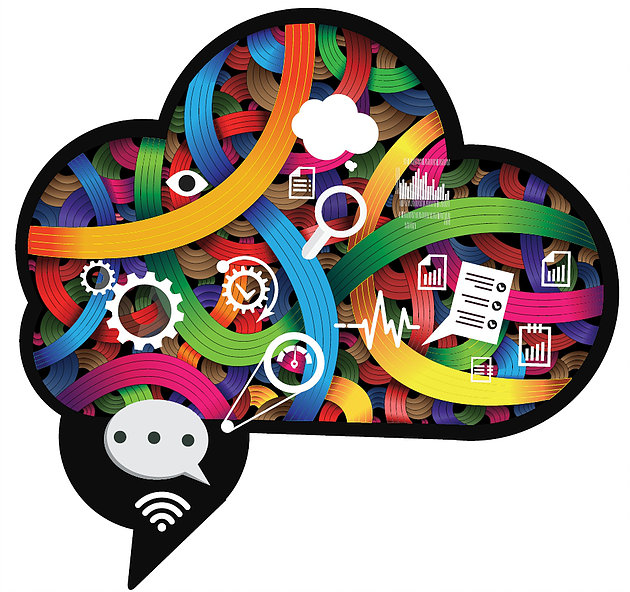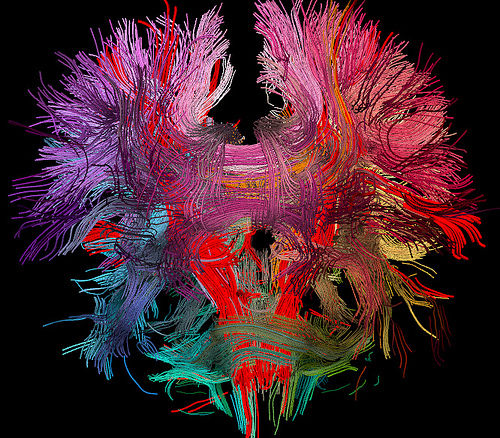
Published in PEOPLE + STRATEGY, The Professional Journal of HR People + Strategy
VOLUME 39 | ISSUE 4 | FALL 2016
Click here to download

Published in PEOPLE + STRATEGY, The Professional Journal of HR People + Strategy
VOLUME 39 | ISSUE 4 | FALL 2016
Click here to download
This post originally appeared at Emergenetics International.

Ever walked into a room for a networking event and looked for someone you know? I have. When I don’t see someone I immediately recognize, I start to look for someone who looks friendly or approachable. When I do see someone I know, I watch his or her face to see if I can drop in on the conversation. Often my look will catch that person’s attention, and we start talking. We’re social beings, and we constantly carry on neural conversations with one another even before we open our mouths.
Certain neurons in the brain are believed to make up the neurological underpinnings of imitation, emulation and empathy. Located in the brain’s social system, motor command neurons fire when we reach out to
pick something up. A subset of these neurons, roughly 20 percent, also fire simply when we watchsomeone perform the same task. Isn’t that amazing? According to V.S. Ramachandran, Ph.D., of The University of California at San Diego, the mirror neuron is different from the motor command neuron because when it fires we’re actually adopting another point of view. Dr. Ramachandran believes that the mirror neuron is also the foundation for culture and how we’ve learned and grown over the millennia. For example, animals learn to adapt fur coats over thousands of generations to adjust to the climate. However, a child could watch his parent kill an animal and make a fur coat and learn that skill in that moment in time. The abilities to imitate, emulate and identify make our culture Lamarckian–the philosophy that an organism can pass on characteristics that have been acquired during its lifetime to its offspring.
Think about the organizations we work for. They’re also Lamarckian in nature. Learning spreads horizontally across the organization as well as vertically through legacy initiatives. Organizational culture is a living system that organizes people, adopts beliefs and creates behavioral structures we all follow. We choose the organizations we work for because the culture feels familiar to us. It might be subconscious, but psychologically speaking, we’re attracted to behavior that we understand. Within these structures we tend to copy and identify with our leaders because of a natural desire to please and belong.
Last month I wrote about Jack, the c-suite executive who wanted to affect change across his organization. He is one of the rare executives I’ve worked with who isn’t afraid of change. He’s more concerned about his people as they navigate the change process to adopt better patterns of behavior. He wants to ensure that they’ll be well taken care of as they move toward the nimble organizational culture he envisions. He believes this will help his team better respond to a fast changing economy. Before he starts though, he needs Peter, the CEO, on his side and for people around them to see that Peter supports this change initiative. This is why the relationship between Peter and Jack is so important. Building relationships is the genesis point for creating change. In today’s culture we can’t make strides without working well with other people, thus the quality of our professional relationships is essential. Understanding the neuroscience behind them helps build awareness of our behavior.
Let’s take a deeper look at Peter, the CEO. He’s youthful, smart, logical and very focused on building a sustainable business that will deliver positive returns in the long term. He believes he’s redefining his company in the marketplace. The press agrees and has been hot on his tail for the past six months. His senior team consists of ten executives, of which Jack is one. Jack stands out as a front-runner to eventually replace Peter. Jack knows this and has worked hard to put himself in positions so he can learn directly from Peter. Peter has reciprocated to Jack.
Peter is considered a people person, although Jack is more talented at understanding people’s points of view and working them into decisions. This has worked to Jack’s advantage as he built rapport with the senior team and his division. He’s described as a divergent thinker who looks for out-of-the-box solutions to problems. The senior team values, respects and trusts Jack. Some try to emulate his style. Traditionally, Peter and Jack have enjoyed a solid, positive relationship.
However, little issues were cropping up and the senior team was starting to notice differences in how they communicated. For example, in good times, Peter may have had an idea and Jack would pick up on it and tweak it to their business needs. Now the conversations go nowhere. Or Peter would start to grill Jack on decisions he’s made rather than trusting, as he had before, that Jack knew what he was doing.
Both men were under emotional stress because Jack’s division was lagging in sales in several key markets. Jack and his team had tried everything to no avail. He hates having to package the message and Peter doesn’t like to do it either. They were both stressed over the same issues and each one wanted to be right. Instead of keeping the problems behind closed doors, word was spreading that Peter and Jack were in trouble. If they didn’t turn their relationship around, it would inhibit progress because it would affect others’ ability to focus on their work. These two men hold leadership roles in the organization. If they’re arguing, the focus will be on them rather than important market trends that are affecting the health and outcome of their business.
My solution was to teach them both something simple about their brains to help them understand why relationships are so important to their business. In Peter’s case, I talked with him about the neuroscience behind building relationships, how we’re constantly reading one another and how the quality of our relationships teaches everyone around us how to imitate, emulate and empathize. Peter changed the course of his relationship with Jack in one instant. He went to Jack’s office and asked him what he needed. He didn’t talk behind a closed door, and others heard what was said and saw the two men smile. This not only relaxed Jack and his team, it put the men back on track in their relationship.
This engagement was one of the most satisfying ones I’ve ever experienced because both Peter and Jack have open mindsets and were willing to take a chance to change their culture in order to turn their business around. It’s working, and I look forward to reporting back in with an update. And remember, the Emergenetics Profile is an excellent resource to use to build rapport among teams. It gives people a framework for understanding their personal behavioral styles and behavior tendencies. Knowing these things can go a long way in helping folks develop best practices for building relationships in the workplace.

Post originally appeared at Emergenetics International.
I just returned from a week-long session with a group of HR leaders at which we discussed current trends in leadership development. One quickly percolated to the top – the mindful leader.
Mindful leadership is a phrase that gets thrown around to describe a leader-like characteristic organizational leaders want to see in others and also incorporate into their own lives. In general, HR leaders agree that organizations need leaders who are not only self aware, focused, strategic and creative, but who also are mindful of how they make decisions and interact with others. Relationships are key in today’s economy. So to help their employees grow, some of these companies practice mindfulness exercises as a part of their leadership development smorgasbord.
This fascinated me. While it’s well documented that mindfulness is generally beneficial, I wondered how these organizations wove a traditional Buddhist practice into their cultures. How was it affecting those who learned a meditative practice as well as those who didn’t choose it? Did employees feel it was mandatory? Who taught the classes? Did the teachers know how to help the students through tough patches? Of those who started a practice, who continued on?
These questions circled because I recently coached an executive who worked in an organization that practiced mindfulness exercises as an option for decreasing stress at work. He was so excited about what he was learning and how it made him feel that he decided to integrate a short meditation into the first 60 seconds of his team and division meetings. Bad call. Because of his status in the organization, people felt obligated to follow his lead and didn’t want to offend him. However, the practice wasn’t a fit with most of his colleagues who felt he should keep his mindfulness discovery to himself. He came close to losing the trust and respect of the people with whom he worked.
Five years ago I started a daily mindfulness practice. I generally enjoy its benefits, but at times I can’t concentrate because of external thoughts or physical discomfort. To be honest, sometimes I don’t want to sit and meditate for 20 minutes so I skip it. I do have a teacher who draws me back in for one reason – I feel less stressed when I meditate on a regular basis. With it I’m more centered, observational and creative. I know this is not very scientific, but I feel better. However, the process isn’t easy and takes focus, drive and commitment. This kind of choice isn’t for everyone; in fact, it’s very personal.
The HR leaders in my group pointed to current research showing that practicing mindfulness leads to more grey matter in the brain. In one particular study, “concentrations of grey matter increased in areas of the brain responsible for memory, learning, emotional regulation, self-referential processing and perspective.” Here’s another point: After an eight-week mindfulness practice, part of the brain’s flight, fight and freeze center, the amygdala, showed decreased density by imaging on the right side. As the amygdala shrinks, the prefrontal cortex, associated with awareness, concentration and decision making, becomes thicker. These relatively new findings seem to hold a lot of promise.
As the HR leaders talked, something else tugged at my thoughts: If someone practices mindfulness, develops better awareness and decreases stress, she’s able to better regulate her environment. After all, if she is more capable, she can work harder and longer. So, who really benefits from the mindful leadership training if it’s sponsored by an organization?
In that moment we were talking about the upsides of mindfulness, but a negative side could be perceived. Furthermore, I know from experience that many organizations like to take on programs without fully thinking through all the ramifications of their choice. The client situation I mentioned earlier in this post illustrates a possible negative outcome. I told the HR leaders that I’m not against the practice, I simply wanted them to realize any potential pitfalls in their desire to help their people. After all, they are uniquely placed to be stewards of organizational culture and leadership development.
Instead of using a traditional Buddhist approach to mindfulness in organizations, I suggest a secular approach that involves noticing the moment. I’ve been drawn more and more to Ellen Langer, Ph.D.’s work in mindlessness and mindfulness at Harvard University. Some have dubbed Dr. Langer the Mother of Mindfulness. She describes mindfulness “as the simple act of actively noticing things with a result of increased health, wellness and happiness.” She encourages people to focus on the present state. She’s never meditated in the Buddhist sense and she says that “eastern notions of meditation inspire post-meditative mindfulness, which is different from actively noticing in a present state.” Her unconventional studies illuminate what neuroscience pinpoints: “Our experience of everything is formed by the words and ideas we attach to them.”
Actively noticing things is quite specific and more powerful than simply saying that one wants to be present. What does “being present” really mean, especially to someone who is potentially unaware or mindless to the present moment? The act of noticing immerses us in the present state and allows us to observe something that will alter our perception of the experience. When I sit back and observe someone, I can either rely on my experience of that person or my judgment, which won’t get me anywhere new. If, on the other hand, I decide to look for three new things about that individual, my perception of the person evolves and grows. All of a sudden it opens a new world based in curiosity. This is awareness at its core.
Here’s what it comes down to: If you actively notice someone’s behavior, you’ll start to see things that weren’t perceptible before. By doing so, you may learn something new about that person that questions a belief or perception you had. That’s what the Emergenetics Profile sets people up for beautifully. By illuminating behavior on a sliding scale, you’re given a framework in which to operate. This is a simple way to practice what Dr. Langer describes as mindfulness—and, according to the research I mentioned above, get smarter in the process.

We’re starting a blog!
Neuroscience fascinates me and I see infinite possibilities for it in the field of leadership. Isn’t it amazing that we are capable of change throughout life? What can we do to make change more deliberate and long lasting? These questions led me to pursue my masters in neuroscience, to conduct studies on how biology affects our actions in organizations and to start this blog. I’ve got a lot to say on the topic.
I want to inspire you to be your most authentic and creative in life — through the understanding of the most powerful tool you possess: your brain.
What’s exciting is that neuroplasticity is real — but it’s more challenging than you might think. We first need to understand what we can change about ourselves, how to approach an effective change process and finally how to maintain it over the long term. (No, we can’t change everything.) I have found that neuroscience grounds the change process — what we become aware of empowers us.
Brain science helps us go beyond personality to understand the biological relationship between thoughts, behavior and perception — vital awareness all leaders must master in order to engender trust, rapport and success within teams and organizations. (There’s some work to be done!) And although we do this naturally to some degree, it’s helpful to have a new perspective to ease the learning pain and to foster greater awareness.
What I’ve seen is that people who use brain science to further themselves as leaders become better at managing themselves, their minds and their environments. They express more happiness, communicate with increased clarity and feel more connected with themselves as well as people around them. Doesn’t that sound good.
Share your thoughts and experiences with me and your colleagues, family and friends. I look forward to a rich, ongoing conversation with you.